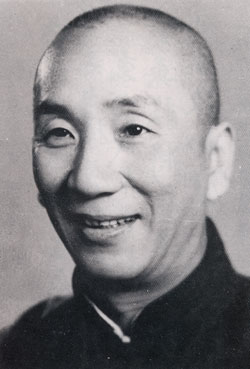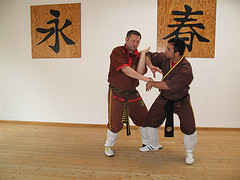
In general, kung fu or kungfu refers to the Chinese martial arts also called wushu and quanfa. In China, it refers to any study, learning, or practice that requires patience, energy, and time to complete. In its original meaning, kung fu can refer to any discipline or skill achieved through hard work and practice, not necessarily martial arts. The literal equivalent of "Chinese martial art" in Mandarin would be 中國武術 zhōngguó wǔshù.

Wing Chun is a concept-based martial art, a form of Southern Chinese kung fu, and a close-quarters system of self-defense. It is a martial arts style characterized by its focus on close-quarters hand-to-hand combat, rapid-fire punches, and straightforward efficiency. It has a philosophy that emphasizes capturing and sticking to an opponent's centerline. This is accomplished using simultaneous attack and defense, tactile sensitivity, and using an opponent's force against them.

Ip Man, also known as Yip Man, was a Hong Kong-based martial artist and a grandmaster of the martial art of Wing Chun when he was 20. He had several students who later became martial arts masters in their own right, the most famous among them being Bruce Lee.

Shaolin kung fu, also called Shaolin Wushu, or Shaolin quan, is one of the oldest, largest, and most famous styles of wushu, or kung fu of Chan Buddhism. It combines Chan philosophy and martial arts. It was developed in the Shaolin Temple in Henan province, Greater China during its 1500-year history. Popular sayings in Chinese folklore related to this practice include "All martial arts under heaven originated from Shaolin" and "Shaolin kung fu is the best under heaven," indicating the influence of Shaolin kung fu among martial arts. The name Shaolin is also used as a brand for the so-called external styles of kung fu. Many styles in southern and northern China use the name Shaolin.

Chinese martial arts, often called by the umbrella terms kung fu, kuoshu or wushu, are multiple fighting styles that have developed over the centuries in Greater China. These fighting styles are often classified according to common traits, identified as "families" of martial arts. Examples of such traits include Shaolinquan (少林拳) physical exercises involving All Other Animals (五形) mimicry or training methods inspired by Old Chinese philosophies, religions and legends. Styles that focus on qi manipulation are called internal, while others that concentrate on improving muscle and cardiovascular fitness are called external. Geographical association, as in northern and southern, is another popular classification method.
The following outline is provided as an overview of and topical guide to martial arts:

Fung Chuen Keung, known as Jim Fung, was a practitioner and teacher of Wing Chun kung fu and founder of the 'International Wing Chun Academy'. He had been training under his master, Tsui Seung Tin (徐尚田), since 1960.

William Cheung or Cheung Cheuk-hing is a Hong Kong Wing Chun kung fu practitioner and currently the Grandmaster of his lineage of Wing Chun, entitled Traditional Wing Chun (TWC). He also heads the sanctioning body of TWC, the Global Traditional Wing Chun Kung Fu Association (GTWCKFA). He is the recipient of a Masters Award for lifetime achievement in Kung Fu from Martial Arts Australia.

Nanquan refers to a classification of Chinese martial arts that originated in Southern China.

Wushu, or kung fu, is a competitive Chinese martial art. It integrates concepts and forms from various traditional and modern Chinese martial arts, including Shaolin kung fu, tai chi, and Wudangquan. "Wushu" is the Chinese term for "martial arts", reflecting the art's goal as a compilation and standardization of various styles.

Lam Sai-wing was a Hung Gar martial artist. He was a student of the Chinese martial artist, acupuncturer and folk hero of Cantonese ethnicity, Wong Fei-hung.
Moy Yat (梅逸) was a Hong Kong martial artist, painter, seal maker, teacher and author. He was a student of the legendary Wing Chun Kung-Fu teacher Yip Man from 1957 until Ip Man's death in 1972.

Weng Chun Kung Fu is a Southern-style Chinese Martial Art.

Dennis To Yu-hang is a Hong Kong martial artist and actor. He started his career as a wushu practitioner and won several awards at various competitions, including a silver medal at the 2002 Asian Games and a gold medal at the 2005 East Asian Games. He became an actor in 2007 and started by playing minor roles in Ip Man (2008), Bodyguards and Assassins (2009) and Ip Man 2 (2010). He is best known for his role as the Wing Chun grandmaster Ip Man in the 2010 film The Legend Is Born – Ip Man.
Xu Huihui is an actress and former competitive wushu taolu athlete who lives in the United States. She is a three-time world champion and is one of the most renowned athletes to represent a European country at the World Wushu Championships. In her acting career, she is best known for portraying Helen Takahama / Widow in the Marvel Cinematic Universe films Black Widow and Shang-Chi and the Legend of the Ten Rings.

The South African Wushu Federation (SAWF) is the national governing body for the development and promotion of the sport of wushu also known as kung fu in South Africa. The Federation was formed in 2002.

Ho Kam-ming was a Macanese-born Canadian martial artist. He was one of the students of martial arts teacher Ip Man in the discipline of Wing Chun.
The United States of America Wushu Kungfu Federation (USAWKF) is the governing body of wushu-kungfu in the United States. The USAWKF manages and selects the members of the US Wushu Team to compete in various international competitions including the World Wushu Championships, World Junior Wushu Championships, World Kungfu Championships, and the World Taijiquan Championships. The USAWKF also develops regional and national activities relating to Wushu, and has had great influence on how wushu taolu and sanda events are run in the United States. The USAWKF is a member of the Pan-American Wushu Federation (PAWF) and the International Wushu Federation (IWUF).

Chu Shong-tin was grand master of Wing Chun kung fu who had lived in Hong Kong. He was the third student of the famous teacher Yip Man, and remained at Yip Man's school to become his senior instructor.
Leung Yat Ho is a former actor and wushu taolu athlete from Hong Kong. He was a two-time world champion in nanquan and was also a triple silver medalist at the Asian Games.













